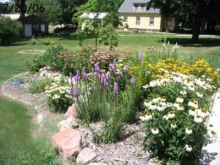Plant A Rain Garden

Established rain gardens are as beautiful as they are functional.

A cross section of a typical rain garden.
Tuesday, March 15 | Gardening Info
About Rain Gardens:
Rain gardens are areas designed to collect and return storm runoff to the water table in a controlled, natural manner. Run off is traditionally channeled into systems of drainage culverts and discharged into natural watersheds. Such sudden, large influxes of unfiltered run-off can have dramatic effects on the chemistry and, therefore, ecosystems of rivers and streams. Rain gardens help mitigate such negative effects by allowing run-off to be slowly drained through the ground where pollutants can be filtered out naturally. The roots of the plants that comprise the rain garden help make the soil more permeable to the water, help stabilize the soil and promote healthy ecosystems of microbes that break down contaminants found in the run-off. The foliage of the plants also helps return some of the water to the atmosphere in the form of water vapor.
Plant your own rain garden:
Rain gardens are ideal solutions for wet or low-lying areas of your property where water drains naturally. Alternatively, you can direct water from your down spouts to your rain garden instead of allowing the runoff to enter the sewer system. Plants used in rain gardens are often native species. Natives are well suited to their local climate and are typically very durable and low maintenance. Natives also provide natural habitat for local bird and butterfly populations.
Plant suggestions for rain gardens:
| Asclepias tuberose | Echinacea purpurea | Little Bluestem |
| Achillea 'Coronation Gold' | Monarda spp. | Rudbeckia fulgida 'Goldstrum' |
| Calamagrostis 'Karl Foerster' | Liatris spp. | Agastache foeniculum |
Plants for consistently moist soil:
| Eupatorium maculatum | Chelone spp. | Panicum 'Heavy Metal' |
| Asclepias incarnata | Mertensia virginica | Marsh Marigold (Caltha) |
| Lobelia cardinalis | Physostegia virginiana |
For more information on-line, start here:
http://www.dnr.state.mn.us/volunteer/mayjun04/raingardens.html




